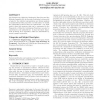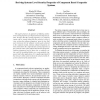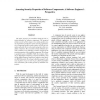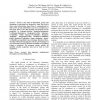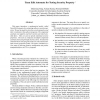97
Voted
COMPSAC
2003
IEEE
15 years 6 months ago
2003
IEEE
This paper explores how to characterise security properties of software components, and how to reason about their suitability for a trustworthy compositional contract. Our framewo...
114
click to vote
TCC
2004
Springer
15 years 6 months ago
2004
Springer
Abstract. We present a general method to prove security properties of cryptographic protocols against active adversaries, when the messages exchanged by the honest parties are arbi...
93
Voted
CISC
2005
Springer
15 years 6 months ago
2005
Springer
The formal analysis of cryptographic protocols has developed into a comprehensive body of knowledge, building on a wide variety of formalisms and treating a diverse range of securi...
87
Voted
CCS
2005
ACM
15 years 6 months ago
2005
ACM
The Framework of Selective Interleaving Functions and the Modular Assembly Kit for Security Properties both provide a basis for the uniform representation and formal analysis of n...
112
Voted
WETICE
2005
IEEE
15 years 6 months ago
2005
IEEE
Formal specification and verification of security has proven a challenging task. There is no single method that has proven feasible. Instead, an integrated approach which combines...
102
Voted
ASWEC
2005
IEEE
15 years 6 months ago
2005
IEEE
This paper proposes an approach of defining systemslevel security properties of component-based composite systems. It argues that the security properties of a composite system ca...
101
Voted
ASWEC
2006
IEEE
15 years 6 months ago
2006
IEEE
The paper proposes an assessment scheme for the security properties of software components. The proposed scheme consists of three stages: (i) a system-specific security requireme...
112
Voted
CIS
2007
Springer
15 years 7 months ago
2007
Springer
— Privacy is the claim of individuals, groups and institutions to determine for themselves, when, how and to what extent information about them is communicated to others. How to ...
IEEEIAS
2007
IEEE
15 years 7 months ago
2007
IEEE
This paper introduces a mathematical model, called Team Edit Automata, for evaluating software security properties. We use the model to describe security properties and their corr...
115
click to vote
CSFW
2007
IEEE
15 years 7 months ago
2007
IEEE
Most model checking techniques for security protocols make a number of simplifying assumptions on the protocol and/or on its execution environment that prevent their applicability...

